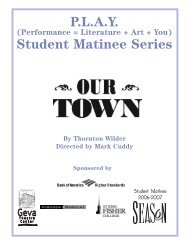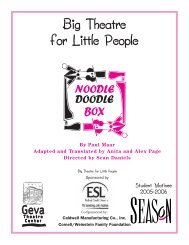Written by Steven Dietz Directed by Peter Amster - Geva Theatre
Written by Steven Dietz Directed by Peter Amster - Geva Theatre
Written by Steven Dietz Directed by Peter Amster - Geva Theatre
Create successful ePaper yourself
Turn your PDF publications into a flip-book with our unique Google optimized e-Paper software.
7<br />
Which Vampire?<br />
“When [I was] asked to direct Dracula, my response was ‘which one?’”<br />
— Director <strong>Peter</strong> <strong>Amster</strong><br />
There have been, claims David J. Skal, the author of Hollywood<br />
Gothic, The Tangled Web of Dracula from Novel to Stage to<br />
Screen, over 200 films featuring Dracula as a major character<br />
and more than 50 theatrical adaptations. “There are as many<br />
different Draculas as there are productions,” offers <strong>Amster</strong>.<br />
He has been portrayed, alternately, as monstrous, evil,<br />
sophisticated, melancholy, lonely, heroic and honorable. How<br />
can one character be interpreted in so many ways? Can he<br />
exhibit more than one of these traits – evil and yet heroic, for<br />
example, or monstrous but sophisticated?<br />
Clockwise from top:<br />
Max Schenk, Bela Lugosi,<br />
Christopher Lee, Frank<br />
Langella and Gary Oldman<br />
as famous vampires<br />
Each production of Dracula, contends director <strong>Amster</strong>, is “an attempt to see Mr.<br />
Stoker’s book through the lens of its own time and inclinations.” In the service of<br />
such inclinations, those storytellers (re)interpreting Dracula have a full menu of folkloric options from which to<br />
choose as they craft their tale. In his essay “Count Dracula and the Folkloric Vampire: Thirteen Comparisons,”<br />
author Patrick Johnson identifies many of the mythical elements found in the great majority of stories concerned<br />
with the legend of Dracula and the legion of followers in its wake. He also explores the historic foundation for each<br />
of these elements and how they’ve come to live within the rich history of vampire mythology. In only one case, the<br />
vampire’s lack of a reflection, is there no counterpart to be found in recorded folklore. (See page 10 for information<br />
regarding the full Johnson essay.)<br />
Which of the following elements commonly found in vampire-themed stories do you notice in this production?<br />
1. Blood Drinking<br />
2. The Vampire’s<br />
Victims Become<br />
Vampires<br />
3. Victims Must<br />
Drink The Blood<br />
of a Vampire<br />
To Become a<br />
Vampire<br />
4. The Vampire’s<br />
Ability to Shapeshift<br />
5. The Vampire’s<br />
Ability to Affect the<br />
Weather<br />
6. Ways to Destroy<br />
the Vampire<br />
7. The Vampire’s<br />
Aversion to Garlic<br />
8. The Vampire’s<br />
Inability to Cross<br />
Running Water<br />
9. The Vampire<br />
in Daylight<br />
10. No Reflection of<br />
the Vampire in<br />
a Mirror<br />
11. The Vampire’s<br />
Intellect and<br />
Social<br />
Sophistication<br />
12. Vampires of<br />
Noble Birth<br />
13. Vampire Cadet<br />
School<br />
Why would the playwright decide to include these elements in his script? If you were writing a vampire story,<br />
which elements would you include and which would you leave out? Why?<br />
With so many considerations in play for those exploring the vampire legend, it is natural that each storyteller would<br />
choose to adapt these folkloric elements to suit their individual tales. Take, for example, the vampire’s alleged<br />
inability to encounter sunlight. In Horror of Dracula, a 1958 British film, Dracula has a very specific reaction to his<br />
contact with daylight as evidenced in this clip: www.youtube.com/watch?v=3gBRe2XMljg. Contrast that<br />
encounter with this scene from 2008’s Twilight: www.youtube.com/watch?v=XXn5uw4LtKM.<br />
Why might the writers for each of these stories choose to interpret this particular myth in such different<br />
fashions? How would the stories change if each vampire had the opposite reaction to daylight? How might their<br />
reaction to sunlight affect other mythic elements of their stories? �<br />
Numbers 1, 2, 3, 4, 6, 7, 9, 10, 11 & 12 are featured in this production of Dracula.<br />
“Dracula can do all these many things … but he is not free.” – Van Helsing





